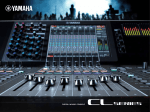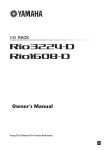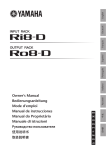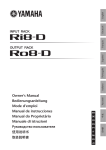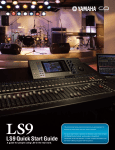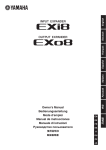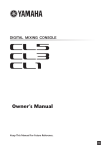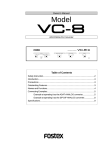Download Yamaha LS9 Specifications
Transcript
LS9 Specifications Dimensions (W x H x D mm) LS9-32: 884 x 220 x 500 PRELIMINARY LS9-16: 480 x 220 x 500 General Specifications Sampling Frequency Net Weight LS9-32: 19.4kg Internal: 44.1kHz, 48kHz LS9-16: 12kg External: 39.69 - 50.88kHz Fader Power Requirements LS9-32: 170 W, 110–240 V, 50/60 Hz 100mm motorized x33 <LS9-32> , x17 <LS9-16> LS9-16: 95 W, 110–240 V, 50/60 Hz LCD Display 320 x 240 dots Graphic Color LCD Temperature Range Operation free-air +10°C to +35°C Phantom Power 48V Storage Temperature Range -20°C to +60°C Analog Input Characteristics Input Terminals GAIN Actual Load Impedance INPUT 1-16 <LS9-16> INPUT 1-32 <LS9-32> -62dB +10dB 3kΩ For Use With Nominal 50-600Ω Mics & 600Ω Lines Sensitivity *1 -82dBu (61.6µV) -10dBu (245mV) Input Level Nominal Max. before clip -62dBu (0.616mV) -42dBu (6.16mV) +10dBu (2.45V) +30dBu (24.5V) Connector XLR-3-31 type with latch(Balanced) *1. Sensitivity is the lowest level that will produce an output of +4dBu(1.23V) or the nominal output level when the unit is set to maximum gain. (all faders and level controls are maximum position.) *2. In these specifications, 0dBu = 0.775 Vrms. *3. All input AD converters are 24bit linear, 128times oversampling. *4. +48V DC ( phantom power ) is supplied to INPUT XLR type connectors via each individual software controlled switch. Analog Output Characteristics Actual Source For Use With Impedance Nominal Output Terminals OMNI OUT 1-8 <LS9-16> OMNI OUT 1-16 <LS9-32> PHONES OUT 75Ω 600Ω Lines 15Ω 8Ω Phones 40Ω Phones Gain Switch*5 +24dB (default) +18dB - Output Level Nominal Max. before clip +4dBu (1.23 V) +24dBu (12.3 V) -2dBu (616mV) +18dBu (6.16V) 75mW 150mW 65mW 150mW Connector XLR-3-32 type (Balanced) *1 Stereo Phone Jack (TRS) (Unbalanced) *2 *1. XLR-3-32 type connectors are balanced.( 1=GND, 2=HOT, 3=COLD ) *2. PHONES stereo phone jack is unbalanced.( Tip=LEFT, Ring=RIGHT, Sleeve=GND ) *3. In these specifications, 0dBu = 0.775 Vrms. *4. All output DA converters are 24bit, 128times oversampling. *5. There are switches inside the body to preset the maximum output level. Digital Input Characteristics Terminal 2TR IN DIGITAL COAXIAL Format IEC-60958 Data Length 24bit Level 0.5Vpp/75Ω Connector RCA Pin Jack Digital Output Characteristics Terminal 2TR OUT DIGITAL COAXIAL Format IEC-60958 Consumer Use Data Length 24bit Level 0.5Vpp/75Ω Connector RCA Pin Jack Dimensions LS9-16 unit : mm LS9-32 220 25 430 480 500 500 220 25 25 834 884 25 Yamaha Mini-YGDAI cards LS9-32 has 2 Mini-YGDAI card slots, the LS9-16 has one. Each slot offers up to 16 I/O channels, with Mini-YGDAI cards available for digital I/O on ADAT, TASCAM or AES/EBU formats, or for extra analog I/O capability. 16 I/O Series MY16-AT MY16-AE MY16-TD 16-Channel ADAT format I/O 16-Channel AES/EBU format I/O 16-Channel TDIF format I/O MY8-ADDA96 MY8-AD96 MY8-DA96 MY8-AE96 MY8-AE96S 8-Channel Analog Input/Output Card 8-Channel Analog Input Card 8-Channel Analog Output Card 8-Channel AES/EBU format I/O 8-Channel AES/EBU format I/O MY16-CII 16-Channel Audio CobraNet format I/O and Control I/O 96 kHz Series (with sample rate converter) Standard Series MY8-AEB MY8-AE MY8-AT MY8-TD MY8-AD24 8-Channel AES 3id-1995 format I/O 8-Channel AES/EBU format I/O 8-Channel ADAT format I/O 8-Channel TDIF format I/O 8-Channel Analog Input Card (24 bit) MY4-AD MY4-DA 4-Channel Analog Input Card (24 bit) 4-Channel Analog Output Card (20 bit) For details please contact: LPA522 This document is printed on chlorine-free (ECF) paper with soy ink. Printed in Japan Good Reasons to Go Digital Digital mixing and processing for live sound has come of age, and there’s no turning back. Throughout the audio industry the most demanding sound engineers and audio company professionals are turning to digital mixing as a way of enhancing quality, efficiency and commercial advantage. If you’re planning to upgrade a small or medium-scale analog system, there are plenty of great reasons to go digital. The Yamaha LS9-16 and LS9-32 are two very good reasons indeed. They offer the most up-to-date and mature digital mixing capabilities in their class, with an interface that makes operation easy even for the inveterate analog user. They do it in consoles that are remarkably compact and lightweight – even the LS9-32 can be tucked under an arm and moved around quite comfortably. Just try doing that with a 32 channel analog console and the racks of outboard gear that would be required to equal the functionality of these digital mixers. Both LS9-16 and LS9-32 can grow with your needs too; they have a second layer of channel processing power that lets you control up to another 16 or 32 channels of audio inputs from digital sources and/or analog sources with no compromises on features or quality. And then there’s the sound. From the acclaimed PM1D digital live sound console right down the line, superlative sound is another reason discerning professionals choose Yamaha Digital Mixing Consoles for critical live sound applications around the globe. 2 Main Features • 16 or 32 top-performance recallable head amplifiers deliver microphone and line sources with extraordinary presence and realism. • An additional 16 or 32 channels of processing power ready to receive audio via the Mini-YGDAI expansion slots, providing a total of 32 or 64 channels! • 4 stereo input channels. • An extensive range of channel functions accessible via Yamaha’s acclaimed Selected Channel interface. • Versatile bus architecture with comprehensive digital patching capability: 16 mix buses, 8 matrix buses, and a stereo and mono bus that can be used in LCR mode. • Virtual GEQ and effect rack offers easy access to built-in graphic equalization and effects that would fill a full-size rack or two if similar analog gear were used. • Built-in USB Memory Recorder/Player eliminates the need for an external device for simple off-board recording, and can supply background music and sound effects as required. • Full-console scene Store and Recall. • Ready to use out of the box with pre-patched effects and pre-fader aux mixes for monitor sends. • One or two Mini-YGDAI slots for easy system expansion. • Compact size 480 x 220 x 500 and 884 x 220 x 500 weigh only 12 and 19.4 kg, respectively. 3 The : Anywhere You Need Advanced Live Sound Support The surprisingly small size and lightweight of the LS9-16 make it a perfect choice for applications that require maximum portability and handling ease. Use it for events or temporary live sound setups, and benefit from the power and performance of much larger and more complex systems in an eminently portable package that can be set up and operated anywhere with ease. The : High Input Capacity and a Generous Bus Structure for Serious Live Sound With 32 input head amps the LS9-32 can comfortably handle the complex and varied source requirements presented by a wide range of live sound applications, but it’s always reassuring to know that you can expand it up to 64 channels by just adding external preamps and Mini-YGDAI interface cards for those extra demanding line-ups. Whether used in an installation or on the road, the LS9-32 will deliver the performance and versatility of large-scale systems in dramatically less space, with less hassle, and significantly lower overall cost. Console lamp accepts the Yamaha option gooseneck lamp LA5000 (sold separately). Compare the Cost and Complexity The LS9-16 can be rack-mounted using an optional rack-mounting kit for optimum integration with any system. Additionally the same kit can be used as fixing tool for the LS9-32. 4 Suppose you need a compact console, but also graphic equalizers for front-of-house and monitors, a couple of effect processors for reverb and delay, compressors and gates, a 2-track player/recorder for BGM and reference recording … that’s already a fairly large rack full of gear, but it’s still a bare minimum for most serious sound applications. Think about transporting and setting up all that gear (don’t forget all the cables you’ll need), and add up the cost in terms of the equipment itself as well as transportation, staff, storage, and maintenance. Now imagine all of that and much more in a single rackmount console that weighs only 12 kg, and you have the LS9-16. It’s all pre-patched and tested in the factory so you just need to connect microphones to the inputs and speakers to the outputs and you are ready for soundcheck. If you need more capacity you can use the Mini-YGDAI expansion port system to connect a couple of rackmount head amplifier and have up to 32 channels without taking up much more space. The advantages are obvious for touring and temporary systems, but installations will also benefit from the significant space savings and reduced cabling requirements. And of course everybody – audience included – benefits from the outstanding versatility and sound these extraordinary digital consoles deliver. 5 LS9 General Function Intuitive Interface for Easy Access and Control The LS9-16 and LS9-32 make immense digital processing power and control flexibility available via an interface that will quickly become comfortable and convenient for the first-time user. Anyone who has ever used a Yamaha digital console before will feel right at home. Fader levels are directly controlled via precision 100-millimeter motor faders for instant hands-on access. Corresponding illuminated switches are provided for channel on/off switching and cueing, and independent LED level meters let you keep an eye on channel signal levels. Yamaha’s acclaimed Selected Channel interface provides efficient access to other channel functions via an ingenious integration of physical controllers and a large color LCD panel. Deeper functions and system settings can be efficiently accessed via the console’s “Display Access” keys and programmed via the LCD display and data entry controls. A “Home” key brings you right back to the main operating mode no matter where you are, so you need never be lost in menus. REAR PANEL 16 or 32 Mono Input Channels Plus 4 Stereo Input Channels Expandable Up to 32 or 64 Channels in Two Layers One of the reasons the LS9 consoles are so compact – and another reason you’ll want to go digital – is that a total of 17 physical faders on the LS9-16, or a total of 33 on the LS9-32, give you fast, easy access to all input channel, mix bus, matrix, and master levels. On both consoles the input channels are available in two fully patchable layers: 1~16 and 17~32 on the LS9-16, or 1~32 and 33~64 on the LS9-32. And you can switch between layers instantly by tapping a single dedicated button. You can organize your inputs so that channels you’ll want to operate most of the time are in the “top” layer, or you can “vertically” link input channels across the two layers for stereo operation. Of course you can link channels “horizontally” in the same layer if you like, but pairing vertically keeps controls you don’t need to operate out of the A headphone jack and level control are conveniently located on the console’s front panel. 6 way. You can even “Y-split” channels to appear in both layers and have a monitor and a FOH layer. There’s also a “Master” layer button that brings all 16 mix bus levels to the console’s faders on the LS9-16, and additionally the matrix levels and mono bus level on the 33-fader LS9-32. In addition to the two input channel layers and master layer, the LS9 consoles feature a “Custom Fader” layer to which you can assign any combination of input and output channel faders your application requires. Stereo inputs are handled in a similar way on the LS9-16, with two stereo inputs on each of the input layers. The LS9-32 provides panel controls for all four stereo inputs. The LS9-16 provides 16 analog inputs built-in, while the LS9-32 has 32 internal analog inputs. Additional inputs can be provided via the LS-9-16’s single rear-panel Mini-YGDAI expansion slot, or the dual expansion slots provided on the LS9-32. 16 Mix Buses, 8 Matrix Buses, Plus Stereo and Mono Buses with LCR Mode The 16 mix buses can function as any combination of 16 auxiliary sends or sub-groups. That’s a lot of AUX knobs and/or faders. However on the LS9 consoles the mix bus levels are controlled via the “1-16, 17-32 or 1-32, 33-64” fader layer with the simple Sends on Fader function. Just touch the “Master” button and faders 1 through 16 directly control the mix bus levels. Each of the mix buses can be easily assigned for mono or stereo operation. You can also choose the send point to be pre or post fader, and when it’s pre-fader you can even select the send point to be pre or post EQ and dynamics. But don’t worry about the choices because Yamaha provides an easily recalled default setup scene that lets you get mixing straight out of the box. The LS9 also features an 8-bus matrix that can be used to provide additional outputs whenever they are needed. The matrix can receive signals from output groups so it can be used to create extra monitor mixes or used for different level and EQ setting in a distributed PA system. And for main output both models have a stereo bus and a mono bus that can either be used independently or in LCR mode with proper LCR pan control. Outputs can be patched to any of eight analog “Omni” outputs on the LS9-16, or 16 omni outputs on the LS9-32. Additional outputs can be provided via the rear-panel Mini-YGDAI expansion slots – one slot on the LS9-16, and two slots on the LS9-32. REAR PANEL 7 LS9 General Function via User Defined Keys (see below) for direct access. Up to 8 mute groups can be specified. High-performance Recallable Head Amps Head amplifier are the analog circuits that are critical to determining the console’s final sound and raising the signal level prior to digital conversion. The LS9 head amps are the finest quality you’ll find in any console in this class and are capable of accepting mic and line level inputs without a switch. In addition to exceptionally low noise and distortion (minimum requirements for any serious head amp), these superb amplifiers deliver exceptional accuracy and presence that contributes to maximum live-sound intelligibility and impact. But there’s more. Although the LS9 head amplifier are analog for quality and “feel” they are still digitally “recallable”, meaning that their gain, phase, and phantom power settings are stored and recalled with the console’s scenes. Comprehensive Channel Functions with Intuitive Selected Channel Control The LS9 consoles have a powerful range of channel functions that can be accessed and used as easily as those on any analog console – the only difference being that if all of these functions were provided on an analog console the modules would be impractically long! Simply press the [SEL] key of the channel you want to control and use the appropriate Selected Channel encoder to adjust as required: HA GAIN Adjusts input-channel head amplifier (pre amplifier) gain to match the channel’s input sensitivity to the source microphone or line input. HA gain is recallable, as are the +48V phantom power and phase settings. PAN Pan control for mono channels, and balance control for stereo channels. The PAN control can be assigned to either standard stereo LR or LCR operation. In the LCR mode a CSR (Center-Side Ratio) control becomes available that can be used to adjust the proportion between center and LR non-center signal. DYNAMICS 1 and DYNAMICS 2 With the default setup DYNAMICS 1 adjusts gate threshold level for input channels or compressor threshold level for mix, matrix, or stereo/mono channels, and DYNAMICS 2 adjusts compressor threshold level for input channels. The actual parameter controlled depends on the dynamics processor selected from the console’s comprehensive dynamics library – including a de-esser for advanced vocal processing. Although initially set up for gating and compression, as described above, you can also use both processors for 8 Sends on Faders Virtual Rack compression if required. Move the cursor to a dynamics parameter and hit the [ENTER] key to access the remaining comp and gate parameters as well as the DYNAMICS preset library. EQ This versatile 4-band fully parametric EQ section affords extraordinary control and quality for all inputs and buses, and includes a variable HPF filter. You can directly control the Q, frequency, and gain of each band from the encoders, or move the cursor to an EQ parameter and hit the [ENTER] key to access the wide-range attenuator, and see a larger graphic representation of the EQ curve. SELECTED SEND This encoder adjusts the send level to the mix or matrix bus currently selected via the MIX/MATRIX keys to the left of the display. Depending on your application you can think of it as an auxiliary, monitor, effect, or group send control. “VARI” pre-EQ and pre-fader modes are provided for auxiliary send applications and a “FIXED” mode is provided for convenient group send operation. Channel Names & Icons When it comes to marking up the console there’s nothing quite like your familiar hand writing on tape for labeling inputs , but the LS9 also offers some inbuilt channel identification capabilities that you’ll appreciate. The number, name, and icon of each channel appears in the upper left corner of the display, and you can enter names of up to 8 characters and select icons from the impressive selection provided for easy channel identification. Electronic names are essential for working with the remote editor in Yamaha Studio Manager too. Virtual Rack with Extensive Effects and EQ Most live sound applications will require graphic equalization for room EQ and effects like reverb or delay for creative sound engineering. The LS9 offers effects from Yamaha’s world leading, industry standard SPX range, and full 31 band graphic EQ as well as the innovative “Flex 15GEQ”. Normally you’d need a rack full of external signal processing gear to support even relatively simple live sound requirements, but not with an LS9 console. Just touch one of the RACK buttons and the virtual effect and EQ rack appears on the display for instant, easy access. Effects and graphic EQ can easily be patched into any channel and output, and of course you can edit the effects in detail to create precisely the sound you need. You can use up to 8 signal processors simultaneously: normally up to 4 effects and 4 graphic EQ units. But since the effect units can also function as graphic EQs, you can use more EQ units if you don’t need all 4 effects … up to a total of 8 graphic EQs if you don’t need any other effects. High-resolution Effects There’s a very good reason that Yamaha digital effects are highly regarded in the professional sound field: they are simply the best there is. In both the LS9-16 and LS9-32 you have an extensive range of top-quality effects – from ambience and echo to modulation and distortion – that you can access and add to the mix when and wherever needed. Standard 31-band or Flex15GEQ The standard LS9 graphic EQ modules are 31-band types for precise response shaping and pinpoint feedback control. But when you need even more graphic EQ capacity and flexibility you can call up the innovative Flex15GEQ modules. Each Flex15GEQ module functions as two 31-band units with 15-bands available at a time. So if you choose to load all of your rack spaces with Flex15GEQ, you have an extraordinarily versatile16 channels of GEQ! Direct EQ Control For direct hands-on control you can adjust individual bands from the console’s faders in much the same way as you’d adjust the EQ bands on an external GEQ unit. With the LS9 -16 you need to select the group of faders to adjust, but on LS9- 32 you can see the full 31band curve. Another convenient-control feature is the ability to instantly reset any band to nominal simply by pressing the corresponding fader’s [ON] key. Mute Groups Mute grouping is another feature that can be great advantage in live sound applications. Any number of channels can be muted or unmuted either via mute master controls in the display, or When working on a monitor mix try using Sends on Fader mode. Touch the currently active MIX/MATRIX button (or press an inactive MIX/MATRIX button twice) to instantly assign the corresponding mix bus sends to the faders so you can visually confirm send levels and adjust them using the high quality 100mm full-length linear faders. Touch the same MIX/MATRIX button again to return to the normal mix mode. Full-console Scene Storage and Recall How long does it take you to zero the settings on an analog console, or reproduce the desired settings for a particular performance? The answer depends on the console and application, but it does take operator time and it’s hard to be accurate and reliable for what can easily be several thousand positions. Scene memory is the digital solution, and if you’ve never used a digital console before you’ll really appreciate the time and effort saved by this feature. A “scene” is a complete snapshot of all the console’s settings. The LS9 consoles lets you store up to 300 complete scenes for instant recall whenever they’re needed. You can, for example, reset the entire console for band changes or different scenes in a theatrical performance in an instant. You can also store basic setups for a number of different types of shows your system may be required to handle, then recall and tweak the settings as required. Recall Focus and Recall Safe Functions Scene recall is an invaluable feature on its own, but with Recall Focus and Recall Safe functions it becomes a tool you won’t want to be without. Recall Focus lets you specify the parameters to be recalled with a particular scene, while Recall Safe works globally to all scenes, allowing you to specify parameters that are not to be altered by any scene recall. For example you could use Recall Safe on input EQs so that any EQ changes you make in the first scene of a play don’t get undone when you recall scene two. The combination of both Recall Safe and Focus lets you easily switch between the live mics on stage and a multirack recorder input and then listen to the playback using the stored scenes used to make the recording. User Defined Keys Since we don’t know exactly what functions you’ll need to access for your particular application, we’ve provided a group of 12 User Defined Keys that can be assigned a wide range of functions. You use them to jump to specific display screens, assign them to function as mute masters for specified mute groups, or assign one for tap-tempo input of delay times. There’s also an innovative “Set by SEL” function with which the channel [SEL] keys perform a range of alternate functions if pressed while the assigned User Defined Key is held: reset the defaults for that channel, turn phantom power on or off, set the channel fader to nominal … and more. Built-in USB Memory Recorder/Player and use it the way it is, or tweak it to suit specific needs. As an example, you might recall a vocal compressor preset from the dynamics library and then adjust the threshold to suit the source, or recall a kick-drum EQ preset and adjust the center frequency to match the drum actually being used. You can also save your edited versions of the presets for easy recall whenever they’re needed again. Versatile Monitoring Capability Touch the “Monitor” display access button for full access to the console’s extensive range of monitor functions: from monitor source selection through talkback and oscillator controls. A headphone jack and level control are conveniently located on the front panel or monitor signals can be routed to one of the Omni output XLRs and slots. Any of the input channels can be assigned to talkback operation for convenient system testing. And of course independent physical [CUE] buttons are provided with each fader for instant, error-free cue monitoring. Flexible Multi-point Metering Most live-sound systems include a CD player and/or recorder of some sort to provide background music and allow recording of the program for reference purposes. That’s one or two more pieces of external equipment that won’t be required with an LS9 console. The LS9-16 and LS9-32 feature a built-in USB Memory Recorder/Player that works with USB memory sticks plugged into the console’s USB port. You can record MP3files and play back MP3, AAC, and WMA files at 96, 128, or 192 kbps. You can even cue playback of specific files from the console’s User Defined Keys! Data Libraries The LS9 data “libraries” provide extensive resources to draw on when setting up effects, parametric EQ, graphic EQ, or dynamics processing. You can recall an appropriate preset In addition to the large stereo level meter, accurate fast-response metering for all channels and buses is easily accessible via the LS9 display. A variety of metering points can also be selected so you have comprehensive visual monitoring of signal levels throughout the entire console. Channel Copy, Move and Clear Here are a few more features that add significantly to the attraction of digital technology for live sound. Channel Copy lets you copy the parameters from any one channel to any number of other channels, Channel Move swaps the parameters and the patching between two specified channels, and Channel Clear clears all parameters of the specified channels. All of these capabilities can dramatically streamline the process of setting up the console or modifying the console settings. 9 Block Diagram LS9 General Function USB Memory for Convenient Data Management and Portability Standard USB memory sticks can be plugged into the LS9 USB port for convenient storage and recall of scenes, patches, user libraries, channel names, preferences … essentially all system data. In addition to providing a secure backup, this makes it easy to transfer data between the console and the LS9 Editor application running on your personal computer, or directly between LS9 consoles. You can program the console’s settings using the LS9 Editor on a computer in your hotel room or on the tour bus – wherever you don’t have access to the console itself – and simply transfer those settings from your USB memory to the console at the venue. Advanced Access Management You might simply want to prevent “accidents” during critical live performances, or limit access to specific functions in order to minimize the need for direct supervision of inexperienced operators. You may have spent hours with an analyzer setting up the EQ to precisely tune the system for a room, for example, in which case you won’t want those settings changed under any circumstances. Access management provides a flexible means of preventing unauthorized access to the console, or restricting access to a limited set of functions. User access can be controlled either via passwords or USB memory keys. The administrator can assign specific functions to each unique password or key, so the user only has to log onto the console with the assigned password or insert the USB key to begin operation at the assigned level. USB memory keys can be easily created either directly via the console or a computer running the LS9 Editor applications software. As an added bonus the same USB memory key used for access can also be used to store the user’s scenes and other preferences. Mini-YGDAI Expansion Cards The LS9-16 has one expansion slot on the rear panel, and the LS9-32 has two. The expansion slots accept a wide range of optional Yamaha and third party Mini-YGDAI I/O cards that can be used to add analog or digital input and output capability in a range of formats. You can even DIGITAL MIXING CONSOLE LS9 use Mini- YGDAI cards to bus-cascade with other consoles for significantly expanded input capacity. Other Rear-panel Features In addition to the analog inputs and outputs and expansion slots, the LS9-16 and LS9-32 rear-panels feature MIDI terminals, word clock input and output connectors that allow full word sync with other digital audio gear, S/PDIF format digital 2-track inputs and outputs, and an Ethernet network connector. LS9 Editor for Online Control or Offline Editing The LS9 Editor application for Yamaha’s Studio manager host program running in MS Windows operating systems gives you off-line programming access to most console parameters. You can set up and edit console parameters anywhere you can use your personal computer – in the office, on the road, in your hotel. A comprehensive graphical interface makes locating and editing parameters easy, and you can download setups from the computer to the console either by directly connecting the computer to the console via an Ethernet cable, or by saving the data to a USB memory stick that can then be plugged into the console’s USB port. You can even remotely control the console from the computer in real time while connected via Ethernet. LS9 Digital vs. Conventional Analog Systems Gate Comp 31 band GEQ (Stereo) 31 band GEQ (Stereo) 31 band GEQ (Stereo) 31 band GEQ (Stereo) 1 2 3 4 Reverb 1 Reverb 2 Delay 1 CD Player Delay 2 MD Recorder 32 Inputs Large Analog SR Console + Outboard Racks The amount of signal processing power packed into the LS9 consoles is really quite impressive when looked at from the perspective of a comparable analog system. Here’s an example: if you wanted to replace a fully loaded LS9-32 with analog gear you’d need a large 32-channel console plus some racks loaded with 32 gates each, some racks loaded with 32 compressors each, another rack containing 10 four GEQ units and four signal processors for effects, and perhaps yet another rack containing your CD player and recording gear. And what a wiring and patching nightmare! When you consider that you get all of this and more in a compact console that a single person can pick up and move around without breaking into a sweat, the choice is obvious. 11






